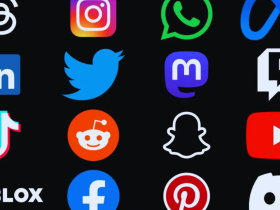In the ever-evolving landscape of social media, new trends emerge constantly, shaping the way people communicate, share, and present themselves to the world. One trend that has gained significant traction in recent years is the concept of “flexing,” a term used to describe the act of showcasing one’s wealth, accomplishments, or unique lifestyle in an often exaggerated or self-congratulatory way. Platforms like Instagram, TikTok, and Twitter have provided users with the perfect stage to flex their achievements—be it through photos of luxury cars, exotic vacations, or personal milestones.
Lexing isn’t just about showing off for the sake of attention; it’s also tied to deeper motivations like seeking validation, gaining admiration, and crafting a specific online persona that resonates with others. But what drives this growing phenomenon, and why has flexing become such a central part of modern social media culture? I will explore the meaning of flexing in social media, the cultural and psychological factors behind it, and why it has evolved into one of the defining trends of our digital age.
What is flexing in social media?
Flexing on social media is a term used to describe the act of showing off or displaying one’s success, wealth, or personal achievements in a way that seeks validation from others. It is a way to highlight aspects of life that are often viewed as aspirational or enviable, such as designer fashion, luxury cars, exotic travel destinations, or a newly acquired status. People use social media to flex by posting images or updates that emphasize their financial status, career growth, or even personal fitness milestones. The purpose is often to gain admiration, recognition, or social status, creating a digital persona that aligns with success or the lifestyle others might envy. While some may flex for motivation or inspiration, it can sometimes foster unhealthy comparisons or create pressure to live up to such ideals.
Common Examples of Flexing in Social Media
Common examples of flexing on social media often revolve around showcasing wealth, status, and personal achievements. One common form is posting about luxury purchases, such as designer clothes, high-end cars, or expensive watches, to display affluence. Another is sharing glamorous travel destinations, often to exotic or exclusive spots, to project an elite lifestyle.
Flexing can also be seen in fitness progress, where individuals flaunt their physical transformation or intense workout routines. Additionally, people often show off by attending exclusive events or VIP gatherings that highlight their social circles. Lastly, flexing can occur through sharing career successes or personal milestones, such as promotions or awards, to emphasize professional achievements.
| Type of Flexing | Description | Platform |
| Wealth Flexing | Displaying luxury items like cars, watches, or jewelry. | Instagram, TikTok |
| Travel Flexing | Posting extravagant vacation photos or experiences. | Instagram, Facebook |
| Achievement Flexing | Sharing professional milestones or personal successes. | LinkedIn, Twitter |
| Fitness Flexing | Sharing before-and-after fitness transformations. | Instagram, TikTok |
| Family/Relationship Flexing | Sharing moments with loved ones to showcase a happy family life. | Facebook, Instagram |
In the digital world, flexing isn’t just about showing off material things; it’s also about projecting an image of success that aligns with cultural ideals of wealth and status. Flexing has evolved from being a private boast to a public statement, with platforms like Instagram providing the perfect medium for individuals to display their lives.
Why Has Flexing Become Popular?
Flexing has taken on a life of its own, especially with the rise of influencer culture and the societal pressure to portray a curated, perfect lifestyle. Social media platforms encourage users to highlight their best selves, and flexing feeds directly into this trend. People often feel compelled to share their achievements, possessions, or vacations to gain validation and approval from others.
Flexing is also a form of self-marketing. Many influencers, celebrities, and even ordinary individuals have turned their social media presence into a branding tool. By flexing, they show their followers that they live a life of success, which can lead to higher engagement rates, increased followers, and more brand deals or opportunities.
| Motivation | Explanation |
| Validation Seeking | People post to get positive feedback, likes, and comments. |
| Aspirational Content | Users want to show they live a successful, enviable lifestyle. |
| Social Influence | Flexing creates trends that others try to imitate. |
| Personal Branding | Influencers and creators use flexing as part of their personal brand. |
| Connection and Status | Flexing can help users feel more connected to others with similar interests. |
Flexing is not just about showing off; it’s also deeply ingrained in social dynamics. Social media provides a platform for individuals to engage in competition, compare their lives to others, and climb the social ladder through likes and followers.
The Impact of Flexing on Social Media Culture
Flexing has had significant cultural effects on social media. It has altered how people view success and has shifted the way individuals engage with others online. Flexing also plays a major role in shaping trends and influencing purchasing behavior. As more people engage in flexing, it becomes a self-perpetuating cycle where others feel the need to keep up or one-up each other.In addition to its influence on lifestyle trends, flexing has also given rise to new forms of online interaction.
For example, influencers and brands now heavily rely on flexing to drive traffic, create brand loyalty, and build a social media presence. But it’s not just influencers—regular people are also using flexing as a way to distinguish themselves in a crowded digital space.While flexing is widely celebrated, it has also faced criticism. Some argue that it perpetuates unrealistic beauty standards, materialism, and a culture of comparison that can be detrimental to mental health. Critics suggest that flexing can encourage unhealthy competition and foster feelings of inadequacy for those who feel they cannot measure up.
The Different Types of Flexing on Social Media
As we discussed earlier, flexing can take many forms. It’s not just about posting pictures of expensive cars or designer clothes—there are several ways individuals engage in flexing on social media. Let’s break down the different types of flexing seen on digital platforms.
Wealth Flexing
Wealth flexing is arguably the most well-known and easily recognizable form of flexing on social media. In this category, individuals showcase their financial success through posts that feature luxury items like high-end cars, expensive watches, designer clothing, lavish homes, or extravagant vacations. The intent behind wealth flexing is to highlight one’s financial achievements and enviable lifestyle, often with the goal of inspiring awe or admiration.
The rise of platforms like Instagram, where curated images reign, has made wealth flexing even more prevalent. People showcase not only material items but also the experiences they can afford, such as private jets, exclusive parties, or elite gatherings. While wealth flexing can boost one’s social status and garner attention, it can also spark a desire to compete or keep up with those who live similarly luxurious lives.
Fitness Flexing
Fitness flexing has gained momentum with the growing culture of health and wellness on social media. This form of flexing involves sharing fitness-related content, from gym selfies to transformation photos, workout videos, or progress updates on fitness goals. It’s not just about showing physical muscles or weight loss but also about showcasing determination, discipline, and personal growth.
People often share their journey, whether it’s through fitness challenges, weightlifting accomplishments, or personal fitness goals being reached. Fitness flexing is particularly popular on Instagram and TikTok, where hashtags like #fitspo (fitness inspiration) or #transformationtuesday encourage people to share their physical progress. Beyond motivation, fitness flexing fosters a sense of community where individuals inspire and support each other’s fitness journeys.
Achievement Flexing
Achievement flexing goes beyond material possessions or physical appearance, focusing instead on personal and professional accomplishments. This form of flexing highlights the milestones people achieve in various aspects of life—whether it’s landing a prestigious job, getting a promotion, graduating from college, running a marathon, or accomplishing a personal goal. Achievement flexing allows individuals to showcase their success and the hard work they’ve put into achieving something significant.
It’s often seen on LinkedIn, where professional accomplishments are shared, but it also appears on platforms like Facebook and Instagram. People post about their achievements to inspire others, celebrate their victories, and solidify their personal or professional brand. This type of flexing can provide a sense of accomplishment while motivating others to pursue their own goals.
Travel Flexing
Travel flexing is about sharing the exotic, luxury, or adventurous experiences one has during their travels. Whether it’s visiting a tropical island, exploring historic cities, or experiencing the thrill of a luxury resort, people often share their travel experiences to show off the places they’ve been and the lifestyle they can afford. Photos of pristine beaches, iconic landmarks, or exclusive travel spots are common forms of travel flexing. This type of flexing also aligns with the growing trend of “workcation,” where people showcase their ability to work remotely from beautiful or unique destinations.
Flexing meaning in social media Travel flexing can also serve as a way to display one’s freedom and flexibility, especially as more individuals embrace the digital nomad lifestyle. It often speaks to an aspirational sense of wanderlust, encouraging others to explore the world while highlighting the cultural and luxury experiences available.
How Flexing Affects Social Media Engagement
Social media platforms reward content that generates high engagement, which includes likes, comments, shares, and views. Flexing often results in increased engagement because it taps into people’s desires to aspire to a better life or lifestyle. When users post content that fits the mold of flexing, it often gets more attention, both from followers and the algorithm.
Many social media influencers and marketers take advantage of flexing to promote products or services. Brands partner with influencers who regularly engage in flexing to showcase their products as part of an aspirational lifestyle. This creates a cycle where flexing promotes engagement, and engagement promotes more flexing.
The Dark Side of Flexing
The dark side of flexing on social media reveals several psychological and emotional challenges. While flexing can certainly be empowering and a way to celebrate achievements, it often leads to feelings of inadequacy, jealousy, and comparison. Constant exposure to others showcasing their success, wealth, or lifestyles can create unrealistic expectations, causing people to feel like they’re falling behind or not measuring up.
This can particularly affect younger users who may be more impressionable and vulnerable to such comparisons. In more extreme cases, flexing has been linked to anxiety, depression, and low self-esteem, as the pressure to maintain a curated, flawless image online grows. The constant cycle of trying to outdo others or achieve a “perfect” social media persona can be emotionally draining, leaving individuals struggling with their sense of self-worth Flexing meaning in social media.
Negative Consequences of Excessive Flexing
Excessive flexing on social media can lead to several negative consequences. It often fosters feelings of jealousy, as people compare their own lives to the curated, idealized versions they see online. This can result in anxiety, depression, and a diminished sense of self-worth, especially among younger users who may be more vulnerable to these pressures.
The constant need to impress others can lead to emotional exhaustion, as individuals feel compelled to maintain a perfect online persona. Over time, this can damage relationships and hinder genuine self-expression, as individuals prioritize validation over authenticity.
| Negative Impact | Explanation |
| Mental Health Issues | Social comparison can lead to feelings of inadequacy and anxiety. |
| Materialism | Flexing reinforces the value of material wealth over other aspects of life. |
| Fake Lifestyles | Many users create a false image of their lives, leading to a lack of authenticity. |
| Online Drama | Excessive flexing can lead to arguments or conflicts between users. |
| Pressure to Maintain Image | The pressure to continue flexing can lead to burnout or dissatisfaction. |
Wrapping Up
As we’ve explored throughout this article, flexing on social media has become more than just a passing trend; it’s a significant cultural shift in how we interact online, express our self-worth, and seek validation from others. While flexing can be a fun and empowering way to celebrate success and achievements, it also raises important questions about authenticity, materialism, and the mental health consequences of constantly comparing ourselves to others.
Flexing meaning in social media As social media platforms continue to grow and evolve, it’s likely that flexing will continue to play a key role in how individuals project their identities and navigate their online relationships. Whether we view it as a healthy form of self-expression or a harmful pursuit of unattainable perfection, flexing remains a powerful force shaping the way we present ourselves in the digital age. It’s clear that, while the trend may evolve, the underlying desire for recognition and affirmation in our social media lives is here to stay.
FAQs
What does flexing mean in social media?
Flexing on social media refers to the act of showing off personal achievements, wealth, or success to gain admiration or recognition. This can include posting about luxury purchases, fitness progress, travel experiences, or professional milestones. It’s a way to showcase a glamorous lifestyle and assert a sense of accomplishment to followers. While it can be empowering, it can also create unrealistic expectations for others.
Is flexing good for personal branding?
Yes, flexing can be an effective tool for personal branding, especially for influencers or entrepreneurs. By showcasing achievements, lifestyle, and success, individuals can create a strong image that attracts followers and potential business opportunities. However, it’s important to balance flexing with authenticity to avoid appearing overly materialistic or shallow. When used strategically, flexing can enhance visibility and credibility Flexing meaning in social media.
Does flexing lead to unhealthy competition?
Flexing can certainly encourage competition, particularly on social media platforms where comparisons are constant. As people see others flaunting success or wealth, they may feel pressured to match or exceed those achievements, leading to unhealthy competition. This can foster anxiety, stress, and a constant need for validation, which could impact overall well-being. It’s important to remember that not everything shared online is a true reflection of real life.
Can flexing be a form of self-expression?
Yes, flexing can serve as a form of self-expression. Many people use social media to celebrate their accomplishments, whether it’s a new job, fitness journey, or personal growth. Flexing can be a way to take pride in one’s achievements and share them with others. When done authentically, it can empower individuals to own their success and inspire others to pursue their goals.
What are the risks of excessive flexing?
Flexing meaning in social media Excessive flexing can lead to several risks, including materialism, mental health challenges like anxiety, depression, and low self-esteem. Constantly comparing oneself to others’ curated posts can create unrealistic expectations and feelings of inadequacy. Over time, the pressure to maintain a perfect online persona can result in emotional burnout and dissatisfaction with real life, as online success doesn’t always reflect reality.
How can flexing affect mental health?
Flexing can negatively impact mental health, especially when it leads to unhealthy comparisons. Seeing others flaunt their wealth or success can cause feelings of jealousy, insecurity, and self-doubt. The pressure to keep up with others’ perceived perfect lives can lead to anxiety, depression, and even a loss of self-identity. It’s important to recognize that social media often highlights the best moments, not the full picture of a person’s life.
What is the difference between healthy and unhealthy flexing?
Flexing meaning in social media Healthy flexing is about sharing accomplishments and successes in a way that inspires and motivates others. It’s done with authenticity and doesn’t aim to belittle or outshine others. Unhealthy flexing, on the other hand, is driven by the need for validation, often involving excessive displays of wealth, status, or lifestyle to create envy. It can lead to toxic comparisons and negatively impact both the person flexing and their audience.




